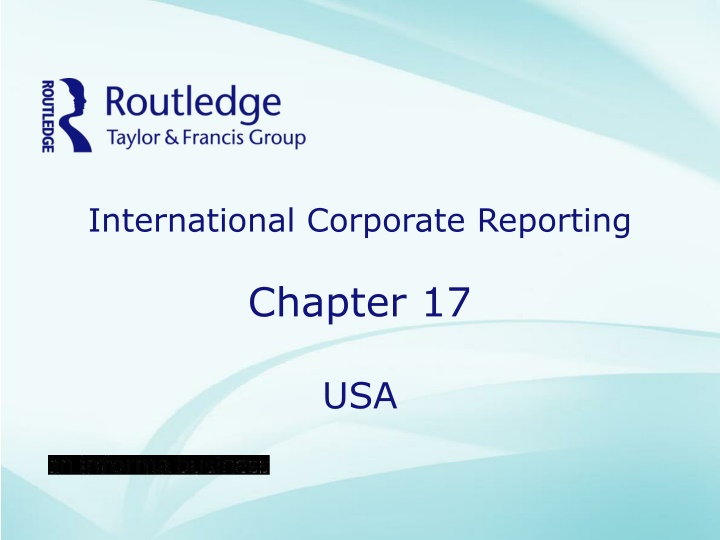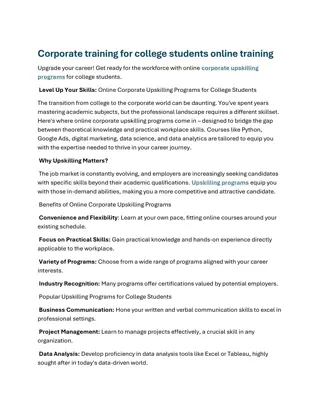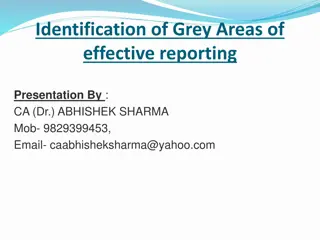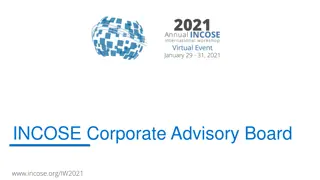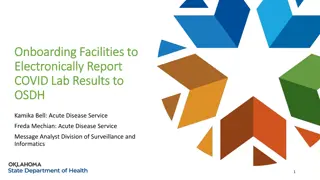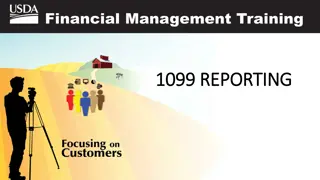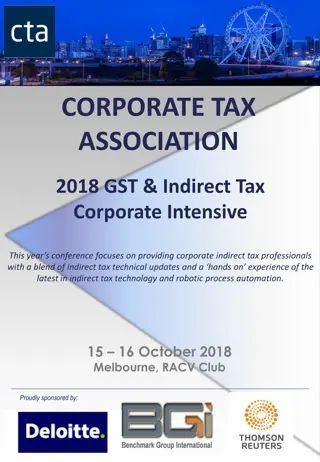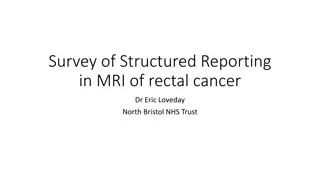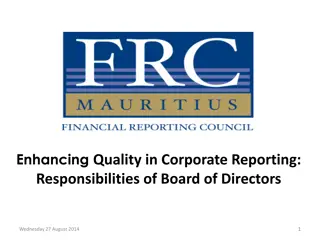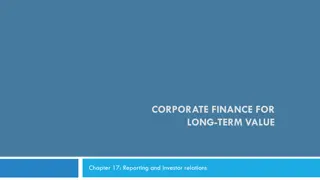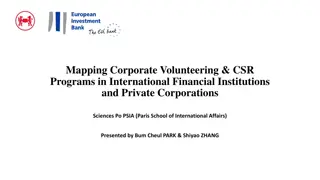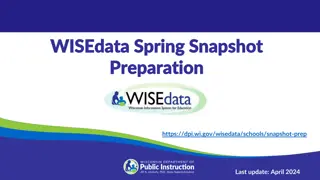International Corporate Reporting
Influential institutional and external factors shape corporate reporting in the USA. The development of accounting regulation, led by bodies like the SEC and FASB, has evolved over the years to ensure financial transparency and accountability. The convergence efforts between FASB and IASB have aimed to harmonize accounting standards, though challenges remain in aligning US GAAP and IFRS. Key stages of convergence from 1996 to 2007 highlight significant milestones in the pursuit of global accounting consistency.
Download Presentation

Please find below an Image/Link to download the presentation.
The content on the website is provided AS IS for your information and personal use only. It may not be sold, licensed, or shared on other websites without obtaining consent from the author.If you encounter any issues during the download, it is possible that the publisher has removed the file from their server.
You are allowed to download the files provided on this website for personal or commercial use, subject to the condition that they are used lawfully. All files are the property of their respective owners.
The content on the website is provided AS IS for your information and personal use only. It may not be sold, licensed, or shared on other websites without obtaining consent from the author.
E N D
Presentation Transcript
International Corporate Reporting Chapter 17 USA
Institutional and external influences Federal republic of separate states. Legal powers over business from both sources. Business may be affected by Executive, Legislative and Judicial arms of federal constitution, also independent regulatory agencies within legal system. Chairman and chief accountant of SEC are appointed by President (executive). US Congress passes laws on federal taxes. US stock exchanges provide new capital AICPA professional body. Exporting US GAAP to other countries
Development of accounting regulation Until 1929 profession was in control 1929 crash led to formation of SEC in 1934 SEC receives accounts of all listed companies for public filing. Published on EDGAR depository. SEC can refuse accounts if they don t comply with standards it requires. SEC accepts FASB accounting standards.
Financial Accounting Standards Board (FASB) 1930s to 1960s accounting standards set via AICPA Boards. 1972 Wheat Committee recommended independent FASB. Has become model for other countries in setting standards. FASB is guided by Statements of Financial Accounting Concepts. Financial Accounting Foundation supports and oversees FASB (also GASB for governmental accounts).
FASB/IASB convergence 2002 agreement between IASB and FASB 2019 becoming apparent that US GAAP and IFRS Standards would remain separate. Two main issues for US regulators: comprehensiveness, auditability, enforceability and comparability of IFRS-based financial statements within and across jurisdictions; IFRS give broad principles to account for transactions across industries, with limited specific guidance and stated exceptions.
(exhibit from chapter 6) Main stages of convergence 1996-2007 and 2008-2012
Main stages of convergence 1996-2007 1996 Act of Congress. Urges SEC to support the development of IAS Standards. 2002 Norwalk Agreement. Memorandum of Understanding. FASB and IASB pledge to make their two sets of regulations compatible. 2005 SEC sets out an agreed Roadmap for the elimination of a reconciliation to US GAAP for non US registrants on US capital markets who apply full IFRS Standards. 2006 SEC/ FASB/ IASB Roadmap for Convergence 2006 2008, Goals set, short and long term. 2007 Removal of requirement for reconciliations to US GAAP/ from IFRS Standards by foreign issuers listed in US.
Main stages of convergence 2008-2012 2008 (November) SEC Proposed Roadmap for the adoption of IFRS Standards by US companies from 2014 (with possible early adoption by some companies from 2009) 2009 Incoming President Obama. New political appointments in SEC- Less enthusiasm for adoption of IFRS Standards. 2011 Timeline removed for adoption of IFRS Standards for use by US companies. 2012 SEC: Final Report on Convergence work plan: No demand from US companies to have their main report under IFRS Standards but look at possibility of companies providing IFRS-based measure of profits as an additional item of information. IASB and FASB continue to work together to eliminate differences when in the best interest of the capital markets.
Sarbanes-Oxley Act 2002 (SoX) Most significant piece of securities legislation since the 1930s. Failure in 2001 of Enron, accounting standards allowed latitude that was subsequently criticised as being too broad. Concerns about the emphasis placed on detailed rules. The detailed standards and guidance within US GAAP laid down the rules-based approach. SoX asked the SEC to study the adoption by the US financial reporting system of a principles- based accounting system.
Principles versus rules Shortcomings of rules: contain numerous tests ( bright lines ) that may be misused to comply with the letter but not the spirit of standards; contain numerous exceptions resulting in inconsistencies of accounting treatment of transactions rules-based standards create a need for detailed and complex implementation guidance.
Principles versus rules, response SEC reported to the House of Representatives in 2003, as required by SoX. Concluded that neither US GAAP nor IFRS Standards, as they existed at that time, were representative of the optimum type of principles-based standard. SEC defined an optimal standard as making a concise statement of accounting principle where the accounting objective has been specified as an integral part of the standard. No further progress apparent.
Private companies Private companies (non-listed) companies are only required to comply with state law. Details vary from state to state, but for almost all companies there will be no requirement to file annual financial information with the state authorities. Effectively allows companies total secrecy (except in respect of tax affairs). No requirement to make information for shareholders available in public. This is in contrast to the position of private companies in many other countries.
FASB codification and due process Accounting Standard Codification Leases is a Topic, numbered 840. Subtopics for Operating Leases (840-20) and Capital Leases (840-30). Within the Subtopics there are Sections for Disclosure of Operating Leases (840-20-50) and Disclosure of Capital Leases (840-30-50). US GAAP are more detailed than IFRS Standards because they also provide industry standards.
FASB due process Substantial secretariat working on standards. Due process involves: appointing a task force of experts to advise on the project; sponsoring research studies and reviewing existing literature on the subject; publishing a discussion of issues and potential solutions; holding a public hearing; and issuing an exposure draft for public comment.
Fair presentation European accounting true and fair view US equivalent of the is wording present fairly in conformity with US GAAP . It is different because of the specific emphasis placed on GAAP. European interpretation of true and fair is not uniform, but the UK view is that true and fair stands above any specific set of rules. US approach seen as legalistic, more judgemental approach in the UK. Another way of expressing the principles versus rules debate.
Annual reporting (see also ch 12) Basic information package on Form 10-K comprises: market price of, and dividends on, common equity, and related security matters; selected financial data; management s discussion and analysis (MD&A); audited financial statements and supplementary data; other information Proxy statement contains further detail
Management discussion and analysis (see also ch 12) Specific information about the company s liquidity, capital resources and results of operations; The impact of inflation and changing prices on net sales and revenues and on income from continuing operations; Material changes in line items of the consolidated financial statements compared with the prior-period amount; Known material events and uncertainties that may make historical financial information not indicative of future operations or future conditions; and Any other information the company believes necessary for an understanding of its financial condition, changes in financial condition, and results of operations.
Differential reporting 2012 the Federal JOBS Act introduced a relaxation of SEC filing requirement for companies coming to the market. Aim was to encourage the growth of small businesses by making it easier for them to go public as an Emerging Growth Company (EGC). EGC company for 5 years from IPO receives concessions on disclosures to the SEC, particularly executive pay and governance matters.
Speed of filing Companies are defined as either large accelerated filers , or accelerated filers or non- accelerated filers . A company s filing speed status is identified on its form 10-K. The due dates for filing the 10-K are: large accelerated filers, 60 days after the fiscal year end; accelerated filers, 75 days after the fiscal year-end; non-accelerated filers 90 days after the fiscal year- end.
Safe harbor protection (see also ch 12) Private Securities Litigation Reform Act of 1995 allows the SEC to clarify what is called a safe harbor of protection against legal action in respect of forward-looking statements, provided these are made outside the financial statements and notes. To obtain the protection, companies must state in Form 10-K the factors that could affect the financial performance or cause actual results to differ from any estimates made in forward- looking statements.
Foreign private issuers, shares listed on a US exchange Definition: 50% or less of securities held by US residents. Conditions, if listed on US exchange: Report to SEC on Form 20-F. May choose US GAAP or IFRS Standards as issued by IASB. (Indicates willingness to enable access to US markets) Any other accounting standards, must give reconciliation to US GAAP.
Foreign private issuers, ADR American Depositary Receipts (ADRs) allow US investors to invest in non-US companies. Shares held by intermediary, issues ADR as a negotiable certificate (can be bought and sold). Level 1 ADR, trading presence, over-the-counter markets only. Level 2 ADR, trading presence on a national securities exchange, may not raise capital. Level 3 ADR, trading presence plus allowed to raise capital.
ADRs and accounting requirements Level 1 ADR, Not required to issue quarterly or annual reports in US GAAP but must have a security listed in a foreign jurisdiction, with an annual report published in English. Level 1 ADRs in OTC markets are used by some major international companies. Level 2 and Level 3 ADRs must report annually to SEC on Form 20-F. Provide useful basis of comparative information for researchers.
Auditing (see also ch 10) Sarbanes-Oxley Act established Public Company Accounting Oversight Board (PCAOB) to regulate the auditing profession, previously self-regulated. SoX requires the Chief Executive Officer (CEO) and Chief Financial Officer (CFO) to sign approval of the financial statements. Audit committees must have members that are independent and disclose whether or not at least one is a financial expert, or give reasons why no such expert is on the audit committee.
Corporate governance Dodd-Frank Act, enacted 2010 after global financial crisis, was intended to significantly restructure the regulatory framework for the US financial system. It extended federal regulation of corporate governance for all public companies. Corporate governance in the US is mainly statutory but there are also guidelines issued by the investor community and the business community.
Proxy statement A proxy is someone who votes on behalf of an investor, applying the decisions of the investor. Proxy statement accompanies the notice to shareholders convening the annual general meeting and is a useful source of information about the governance of a company. Proxy statement is intended to help the investor make an informed decision and is required by SEC regulation. It includes: details of the board members; their compensation package (rewards as directors); report of the audit committee; fees paid to the auditor; information on related-party transactions; and the distribution of major shareholdings.
Research examples Reconciliation to US GAAP Before 2007, reconciliations published in Form 20-F indicate magnitudes of differences. After 2007, looking for effect of removing the requirement where IFRS Standards used. SEC documentation in public domain Comment letters from SEC staff Enforcement notices issued by SEC Classification studies Identifying Anglo-American influence
